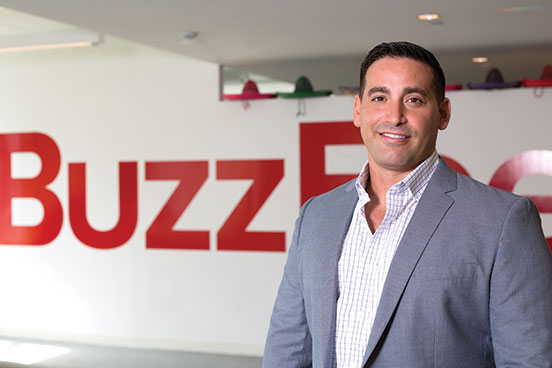
Social-Media Mavens
Stephen Loguidice, B.A.’02

Photo: Sarah Stone for BuzzFeed
Leading the Buzz
By Stephen Shoemaker, B.A.’02
It’s one thing to jump onto the content-marketing bandwagon to tell brand stories. It’s another to have driven the wagon all along. That’s what Stephen Loguidice and his colleagues at BuzzFeed have done since 2010, when they pioneered a new way for advertisers to get in front of the public.
Loguidice remembers: “We were the ones saying that everybody needs to start thinking differently, because consumption habits have changed drastically: Social [media] is the new starting point, and companies need to be looking this way. We were shouting it from the mountaintops.”
In 2010, digital marketing equated to obnoxious banners, interstitial ads and video pre-roll. As the first salesperson brought on board to help monetize BuzzFeed, Loguidice was at the forefront of helping brands create content people would find compelling, humorous or interesting enough to share on social-media platforms like Facebook and Twitter. “People were throwing around the word ‘content,’ but there was no context behind it. We were the only ones doing it,” says Loguidice, who earned his B.A. in economics with a minor in business administration. He now serves as BuzzFeed’s vice president of Brand Strategy for the East Coast.
One early client was Comedy Central, for “Tosh.0,” which – as a TV show centered around Web content – was a perfect fit for BuzzFeed. Another client was General Electric, with its “Ecomagination” campaign. As an innovative company with “a very strong message” about its identity, Loguidice observes, GE “wasn’t trying to sell anything right then and there.”
As BuzzFeed expands into emerging social-media outlets like Pinterest and Snapchat, and into producing its own online video programming and, potentially, feature-length films, the central philosophy of good content marketing still applies, Loguidice says. “The core foundation is: How do I make something for people, make it for social [media], and build it to be spread and consumed on these platforms that people are already using?”
Next: Teru Kuwayama, B.A.’93


